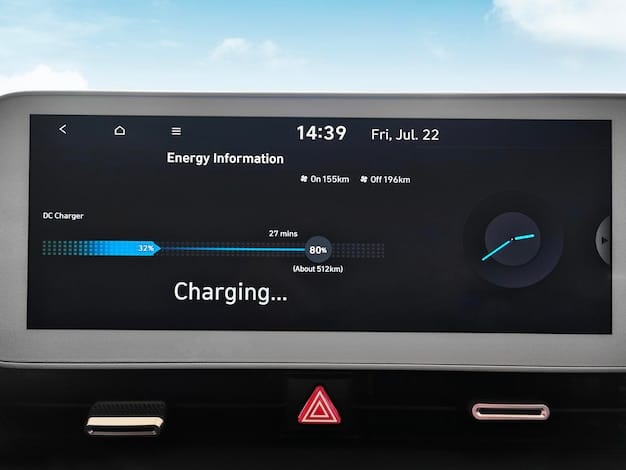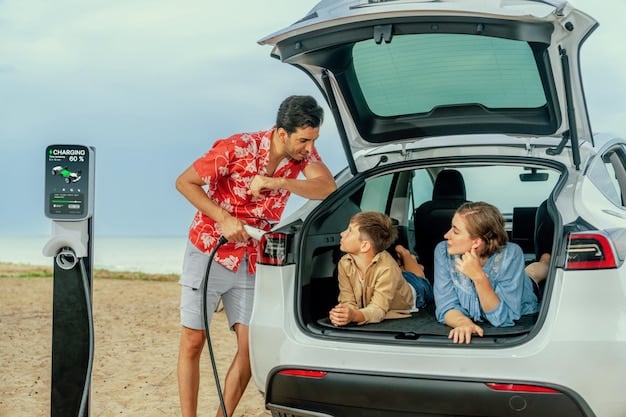EV or Not? Calculate Your Sustainable Transportation Savings

Making a decision about sustainable transportation: is an electric vehicle right for you? Calculate your potential savings by evaluating various factors, including upfront costs, fuel efficiency, maintenance, incentives, and your driving habits, to determine if an EV aligns with your financial and environmental goals.
In a world increasingly focused on environmental stewardship and financial prudence, the question of whether an electric vehicle (EV) is the right choice for you has never been more pertinent. Beyond the environmental benefits often cited, understanding the tangible financial implications – how to calculate your potential savings – is crucial for making an informed decision. This guide aims to navigate the complexities, providing a clear pathway to assess if an EV truly aligns with your lifestyle and budget.
The shift to electric: understanding the landscape
The automotive industry is undergoing a monumental transformation, with electric vehicles at the forefront of this revolution. From sleek sedans to robust SUVs, the range of EVs available is expanding rapidly, offering consumers more choices than ever before. This shift is driven by a confluence of factors, including growing environmental concerns, advancements in battery technology, and increasing governmental support through incentives and infrastructure development. Understanding this evolving landscape is the first step in deciding if an EV journey is for you.
The promise of EVs extends beyond zero tailpipe emissions. They offer a distinct driving experience, often characterized by instant torque, quiet operation, and reduced maintenance needs due to fewer moving parts. However, the transition involves more than just a different kind of engine; it necessitates a re-evaluation of charging habits, range considerations, and the long-term financial picture. It’s a holistic shift in how we perceive personal mobility.
Evolution of EV technology and market trends
Battery technology has seen exponential growth in recent years, leading to longer ranges and faster charging times. Early EVs were often criticized for limited range and slow charging, but today’s models can travel hundreds of miles on a single charge and offer rapid charging capabilities that can replenish a significant portion of the battery in minutes. These advancements are making EVs more practical for daily use and long-distance travel, directly addressing previous barriers to adoption.
- Increased battery capacity and energy density.
- Faster charging infrastructure and home charging solutions.
- Expansion of EV models across various segments.
- Growing consumer awareness and acceptance.
Market trends indicate a strong upward trajectory for EV sales, fueled by consumer demand and regulatory pushes towards greener transportation. Many countries and regions have set ambitious targets for phasing out gasoline-powered vehicles, cementing the role of EVs as the future of personal mobility. This market momentum suggests a future where EVs are not just an alternative, but the norm.
The global shift towards sustainable practices is not just a trend; it’s a necessity. Transportation accounts for a significant portion of global greenhouse gas emissions, making the transition to electric vehicles a critical component of climate action. As more countries commit to reducing their carbon footprint, the incentives for consumers to adopt EVs are only likely to grow, making the decision to go electric increasingly financially viable and environmentally responsible.
In summary, the electric vehicle revolution is well underway, marked by significant technological advancements and a supportive market environment. This landscape offers a compelling case for considering an EV, not just for environmental reasons, but for a potentially more efficient and enjoyable driving experience. The ongoing developments promise an even brighter future for sustainable transportation.
Upfront costs vs. long-term savings: a detailed breakdown
One of the most persistent misconceptions about electric vehicles is their prohibitive upfront cost. While it’s true that the retail price of an EV might sometimes be higher than a comparable gasoline-powered car, this initial investment often overlooks the substantial long-term savings that an EV can offer. To truly understand if an EV is right for you, a detailed financial breakdown is essential, moving beyond the sticker price to consider the total cost of ownership.
The economics of EV ownership are complex, involving a delicate balance between initial expenditure and operational savings. Factors like fuel costs, maintenance, insurance, and available incentives all play a crucial role in determining the true financial impact over the lifespan of the vehicle. By taking a comprehensive view, potential owners can uncover significant financial advantages that might not be immediately apparent.
Comparing purchase prices and incentives
The initial purchase price of an EV can vary widely, influenced by model, battery size, and features. However, several government incentives are designed to offset this cost. The federal tax credit in the U.S., for instance, can provide up to $7,500 towards the purchase of a new EV, significantly reducing the effective price. State and local incentives, such as rebates, tax exemptions, or free charging programs, can further sweeten the deal, making EVs more accessible.
- Federal tax credits for new and used EVs.
- State and local rebates or incentive programs.
- Tax exemptions for EV purchases.
- Special rates or discounts on insurance.
These incentives are dynamic and can change based on legislative updates and specific vehicle models. It’s crucial for prospective buyers to research the current incentives available in their region and for the specific EV they are considering. Factoring these into the equation provides a more accurate picture of the real purchase cost, often bridging the gap between EVs and their internal combustion engine (ICE) counterparts.
Beyond direct purchase incentives, some programs offer support for installing home charging infrastructure, reducing another potential upfront cost. The availability of these various forms of financial aid underscores a deliberate effort to accelerate EV adoption, making them an increasingly attractive option for a broad range of consumers. Understanding and leveraging these incentives is a key part of calculating your potential savings.
In conclusion, while the sticker price of an EV might seem daunting at first glance, a thorough evaluation that includes all available incentives often reveals a much more palatable initial investment. These financial aids are a testament to the growing support for sustainable transportation, making the switch to electric both environmentally sound and economically prudent.
Fuel and energy costs: gasoline vs. electricity
Perhaps the most significant component of long-term savings with an electric vehicle comes from the reduced cost of “fuel.” Charging an EV with electricity is, in most cases, considerably cheaper than filling up a gasoline tank, especially when charging at home during off-peak hours. This difference in energy costs accumulates substantially over time, representing a major financial advantage for EV owners.
Understanding the nuances of electricity pricing, including time-of-use rates and various charging methods, is key to maximizing these savings. Unlike gasoline prices, which can fluctuate wildly due to global events, electricity rates tend to be more stable and predictable, allowing for better budget planning and fewer financial surprises. This predictability is a compelling argument for making the switch.
Calculating your daily charging costs
To estimate your charging costs, you’ll need two main pieces of information: the electricity rate in your area (measured in dollars per kilowatt-hour, or kWh) and the efficiency of the EV you’re considering (measured in terms of miles per kWh, or MPKWh). Most EVs consume between 0.25 and 0.35 kWh per mile. With an average electricity rate, you can easily calculate your daily or monthly charging expenses.
For example, if your electricity rate is $0.15/kWh and your EV consumes 0.3 kWh/mile, driving 100 miles would cost you $4.50 (100 miles * 0.3 kWh/mile * $0.15/kWh). Compare this to a gasoline car getting 30 miles per gallon (MPG) with gas at $3.50/gallon: 100 miles would cost $11.67 (100 miles / 30 MPG * $3.50/gallon). The savings are clear.
- Identify your local electricity rates (on-peak vs. off-peak).
- Determine the EV’s energy efficiency (kWh per mile).
- Estimate your average daily/monthly mileage.
- Factor in public charging costs, which can be higher.
Many utility companies offer special rates for EV owners, encouraging off-peak charging to balance grid demand. Taking advantage of these programs can further reduce your charging costs and enhance your savings. Smart charging systems can also be programmed to charge your EV during the cheapest hours, automating this cost-saving strategy without additional effort.

Public charging networks provide convenience for longer trips, but their rates can vary significantly, often being higher than residential electricity. While these are essential for range anxiety, minimizing their use by relying primarily on home charging maximizes your overall savings. Think of public chargers as supplemental fuel stops, rather than your primary energy source.
By carefully calculating and optimizing your charging habits, the switch to an EV can result in substantial savings on fuel costs alone. This sustained financial benefit is a core reason why electric vehicles are increasingly viewed not just as an environmental choice, but a financially sound investment for the long haul.
Maintenance and insurance: unexpected savings
Beyond the obvious savings at the “pump,” electric vehicles often present surprising financial benefits in terms of maintenance and, in some cases, insurance. The fundamental design of an EV, with significantly fewer moving parts and simpler mechanical systems than a traditional internal combustion engine (ICE) vehicle, translates directly into reduced maintenance needs and lower long-term repair costs. This often overlooked aspect contributes significantly to the total cost of ownership.
The perception that EVs are expensive to repair or insure due to their new technology is gradually changing as the market matures. As technicians become more familiar with EV systems and parts become more readily available, these costs are becoming more competitive. This shift represents another compelling reason to explore the full financial picture of EV ownership.
Reduced maintenance for EVs
Electric vehicles do not require oil changes, spark plug replacements, or complex transmission servicing, which are routine and often costly maintenance items for gasoline cars. The regenerative braking system, common in EVs, also reduces wear on brake pads and rotors, extending their lifespan. This minimal maintenance schedule can lead to substantial savings over the vehicle’s lifetime.
While EVs still require standard maintenance items like tire rotations, cabin air filter replacements, and occasional fluid checks (for coolant, for example), the absence of an internal combustion engine eliminates many of the most frequent and expensive service appointments. This means less time at the mechanic and more money in your pocket.
- No oil changes or related engine fluid replacements.
- Reduced brake wear due to regenerative braking.
- Fewer moving parts, leading to less mechanical failure.
- Longer intervals between scheduled service appointments.
The battery pack, a core component of an EV, is typically covered by a lengthy warranty (often 8 years or 100,000 miles), providing peace of mind against costly battery replacements. As battery technology improves and costs decrease, the long-term reliability of EV batteries is becoming less of a concern, further solidifying the maintenance cost advantage.
Regarding insurance, while some early EVs had higher premiums due to repair costs or perception of risk, this trend is shifting. As more EVs hit the road and insurers gather more data, premiums are becoming more aligned with comparable ICE vehicles. Some insurers even offer discounts for EVs due to their advanced safety features or the perception of EV drivers as being more environmentally conscious and therefore less risky.
The combined effect of lower maintenance requirements and potentially competitive insurance rates makes the financial case for EVs even stronger. These “hidden” savings, when added to the significant fuel cost reductions, paint a comprehensive picture of long-term financial benefits that go beyond the initial purchase price.
Lifestyle considerations: charging habits and range anxiety
While the financial case for electric vehicles is increasingly compelling, the decision to switch also involves significant lifestyle considerations. Adapting to new charging habits and managing potential “range anxiety” are practical aspects that prospective EV owners must evaluate. Understanding how an EV fits into your daily routine is as important as understanding its financial benefits.
Moving from a gasoline car to an EV is not just about changing the fuel source; it’s about shifting your mindset around “refueling.” Instead of infrequent, quick trips to a gas station, EV charging often involves more frequent, slower charges, typically at home overnight. This fundamental difference requires a slight adjustment in daily habits but offers unparalleled convenience once integrated.
Charging at home and on the go
The vast majority of EV charging occurs at home, transforming your garage or driveway into your personal “fueling station.” Installing a Level 2 charger at home allows for convenient overnight charging, ensuring your vehicle is fully charged each morning. This eliminates the need for gas station stops altogether for most daily driving, saving time and simplifying your routine.
For longer journeys or when home charging isn’t feasible, public charging networks provide essential support. These networks are expanding rapidly, offering a mix of Level 2 and fast DC (Direct Current) chargers. While public charging can be more expensive than home charging and requires planning, it’s increasingly reliable and accessible, mitigating concerns about running out of power.
- The convenience of overnight home charging.
- Planning longer trips around public fast charging stations.
- Availability of workplace charging options.
- Utilizing charger locator apps for seamless travel.
Range anxiety, the fear of running out of charge before reaching a charging station, is a common concern for potential EV owners. However, with modern EVs offering ranges well over 200 miles, and the proliferation of charging infrastructure, this anxiety is often overblown for typical driving habits. Most daily commutes are well within the range of even entry-level EVs.

For those who frequently undertake long road trips, careful planning using EV route planner apps that identify charging stops is crucial. These tools make long-distance travel in an EV just as feasible as in a gasoline car, requiring a slightly different preparatory approach. The evolving charging ecosystem and increasing EV ranges are steadily eroding this concern.
Ultimately, transitioning to an EV means embracing a new way of powering your vehicle. While it requires some initial adjustments to charging habits and a careful consideration of range for specific lifestyles, the convenience of home charging and the growing public infrastructure make it a practical and often superior alternative for many drivers seeking sustainable transportation solutions.
Environmental impact and social responsibility
Beyond the personal financial implications, choosing an electric vehicle carries significant environmental weight and aligns with broader goals of social responsibility. The transportation sector is a major contributor to greenhouse gas emissions and urban air pollution. Opting for an EV helps mitigate these impacts, contributing to cleaner air, healthier communities, and a more sustainable future. This ethical dimension is a powerful motivator for many to make the switch, extending the benefits far beyond individual savings.
While the electricity used to power EVs may come from a mix of sources, including fossil fuels, the overall lifecycle emissions of an EV are almost always lower than an equivalent gasoline car, especially as renewable energy sources continue to grow. This “well-to-wheel” analysis reveals a clear environmental advantage, positioning EVs as a key tool in combating climate change.
Reducing your carbon footprint
Electric vehicles produce zero tailpipe emissions, meaning they do not release harmful pollutants like nitrogen oxides or particulate matter directly into the atmosphere during operation. This immediately improves local air quality, particularly in urban areas, leading to better public health outcomes. The reduction in smog and other airborne pollutants is a direct and tangible benefit for everyone.
- Zero tailpipe emissions, improving urban air quality.
- Lower overall lifecycle carbon footprint compared to ICE vehicles.
- Support for the growth of renewable energy infrastructure.
- Reduced noise pollution in neighborhoods.
The environmental benefit of EVs dramatically increases as the electricity grid incorporates more renewable energy sources like solar and wind power. As countries invest more heavily in clean energy generation, the carbon footprint associated with charging an EV continues to shrink, making the act of driving even more sustainable over time. This makes your choice of vehicle part of a larger, positive feedback loop for environmental progress.
Beyond air quality and carbon emissions, EVs also contribute to reduced noise pollution. Their quiet operation, especially at lower speeds, makes roads and neighborhoods more peaceful, enhancing the quality of life for residents and pedestrians. This subtle but significant benefit often goes unnoticed until experienced firsthand, making daily commutes more serene.
Moreover, the adoption of EVs signals a collective commitment to social responsibility. It drives innovation in battery technology, charging infrastructure, and smart energy management systems. By choosing an EV, consumers become active participants in this technological and environmental evolution, supporting industries that are building a greener future. This choice goes beyond personal convenience; it’s a statement about values.
In conclusion, the environmental and social benefits of electric vehicles are profound. From cleaner air and reduced greenhouse gas emissions to quieter communities and support for renewable energy, choosing an EV is a decision with far-reaching positive impacts. It’s a key step towards a more sustainable and responsible approach to personal transportation, offering value that extends well beyond mere financial savings.
Calculating your potential savings: a practical guide
Now that we’ve explored the various facets of electric vehicle ownership, it’s time to consolidate that information into a practical approach for calculating your potential savings. This isn’t just about comparing sticker prices; it’s about a comprehensive total cost of ownership analysis that considers every financial variable. By methodically evaluating these factors, you can arrive at a clear, data-driven decision about whether an EV is suitable for your budget and lifestyle.
This guide will walk you through the necessary steps to perform your own savings calculation, allowing you to personalize the assessment based on your specific circumstances, including your driving habits, local electricity rates, and available incentives. Taking the time to do this detailed analysis will empower you to make a confident and financially sound choice.
Step-by-step savings calculation worksheet
To begin, gather specific financial data relevant to your situation. This includes the retail price of the EV you’re considering, any state or federal incentives you qualify for, your average annual mileage, and your local electricity rates. Also, research the average maintenance costs for both the EV and a comparable gasoline vehicle to ensure a fair comparison.
Start by calculating the net purchase price of the EV after applying all eligible incentives. Then, estimate your annual “fuel” costs for both an EV and a gasoline car based on your driving habits and current energy prices. This is often the largest variable in long-term savings. Don’t forget to consider a home charger installation cost as part of the upfront EV investment.
- Calculate Net EV Purchase Price (MSRP – Incentives).
- Estimate Annual EV Charging Costs (Mileage * kWh/mile * $/kWh).
- Estimate Annual Gasoline Costs (Mileage / MPG * $/gallon).
- Project Annual Maintenance Savings (Average ICE vs. EV costs).
- Factor in potential insurance differences and registration fees.
Once you have these figures, you can subtract the estimated annual operational costs of the EV from those of the gasoline car to determine your annual savings. Multiply this by your projected ownership period (e.g., 5 or 10 years) to get a significant long-term savings estimate. Remember to account for inflation or potential changes in fuel prices, though these are harder to predict.
Consider also the resale value. While still a developing market, used EVs are generally holding their value well, driven by strong demand for sustainable options. Though harder to quantify, a better resale value can also contribute to your overall financial benefit from choosing an EV. This comprehensive approach ensures that no stone is left unturned in your financial assessment.
Performing this detailed savings calculation empowers you to move beyond general statements about EV benefits and toward a personalized evaluation tailored to your financial situation. It allows you to see the tangible monetary advantages that an electric vehicle can offer over its lifetime, making the decision to go electric not just a choice for sustainability, but a smart financial move. This granular analysis is the ultimate tool in determining if an EV is truly right for you.
| Key Aspect | Brief Description |
|---|---|
| ⚡ Fuel Savings | Electricity is generally cheaper per mile than gasoline, leading to significant long-term savings. |
| 🛠️ Lower Maintenance | EVs have fewer moving parts, reducing routine maintenance like oil changes and brake wear. |
| 💰 Incentives & Credits | Federal, state, and local incentives can significantly reduce the upfront purchase cost of EVs. |
| 🌿 Environmental Impact | Zero tailpipe emissions contribute to cleaner air and a reduced carbon footprint, supporting environmental goals. |
Frequently Asked Questions
▼
Yes, electric vehicles generally have a lower overall carbon footprint compared to gasoline cars, even when considering battery manufacturing and electricity generation. While battery production has an initial environmental cost, EV lifecycle emissions are significantly lower, especially as renewable energy sources power the grid. They also produce zero tailpipe emissions, improving local air quality.
▼
Charging an EV at home will increase your electricity bill, but typically at a lower cost per mile than gasoline. The exact increase depends on your electricity rates, the EV’s efficiency, and your driving habits. Many utility companies offer special time-of-use rates for EVs, allowing for cheaper charging during off-peak hours, further maximizing savings.
▼
The U.S. federal government offers a tax credit of up to $7,500 for the purchase of new electric vehicles that meet certain battery component and critical mineral requirements, and are assembled in North America. Additionally, many states and local municipalities provide their own rebates, tax incentives, or other benefits for EV buyers, which can significantly reduce the upfront cost.
▼
For most daily driving, range anxiety is becoming less of a concern due to increased battery ranges (many EVs offer 200+ miles) and expanding charging infrastructure. While long road trips require more planning to locate charging stations, advances in fast-charging technology and the proliferation of public chargers make extended travel increasingly feasible and convenient for EV drivers.
▼
EVs generally require significantly less maintenance than gasoline cars. They don’t need oil changes, spark plug replacements, or extensive transmission servicing. Regenerative braking also reduces wear on brake pads. While regular inspections and tire rotations are still necessary, the absence of complex internal combustion engine components leads to lower long-term maintenance costs and fewer trips to the mechanic.
Conclusion
The journey towards sustainable transportation is multifaceted, and deciding whether an electric vehicle is right for you involves a careful evaluation of financial, lifestyle, and environmental factors. From the long-term savings on fuel and maintenance to the significant positive environmental impact, the advantages of EVs are becoming increasingly clear. By taking the time to calculate your potential savings and assess how an EV fits into your daily life, you can make an informed decision that benefits both your wallet and the planet. The future of driving is electric, and with increasing accessibility and growing support, now might be the perfect time to join the revolution.





